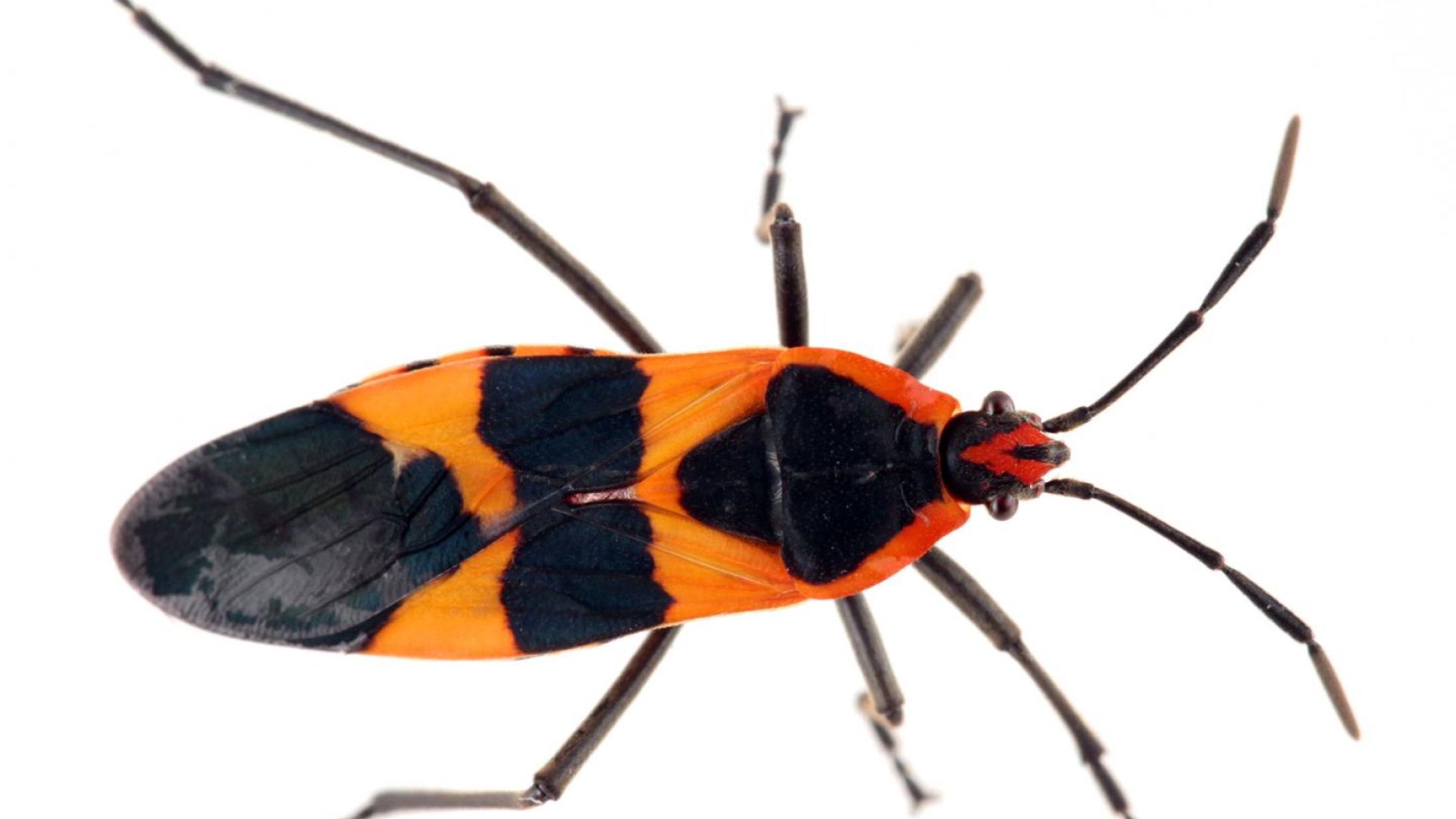Milkweed Bug Genome Revealed
I’ll admit that I have long admired the beauty of the large milkweed bug Oncopeltus fasciatus, without knowing anything about it. So I was pleased to read of the recent publication of its genome sequence, an effort undertaken by 83 researchers working as 27 teams in 10 nations. The findings are reported in Genome Biology.
Most of the 100+ insect species that have had their genomes sequenced are homometabolous, which means that they develop through several stages of larvae, metamorphose, and then burst from their cocoons looking completely different. (See “The Making of a Mutant” for a scintillating view of fruit fly larvae living in goop in a milk bottle.) Flies, beetles, wasps, and butterflies are among the homometabolous.
In contrast, milkweed bugs are hemimetabolous. The species of this group are less well represented among the sequenced, although they are more numerous. The juvenile stages of milkweed bugs are tiny, flightless versions of the adults, called nymphs, that have more orange.
The hemimetabolous insects have trademark mouthparts that pierce and suck, and include agricultural pests and vectors of human disease, like the kissing bugs that deliver Trypanosoma cruzi, the cause of Chagas’ disease. A more familiar hemimetabolous insect is the bed bug Cimex lectularius.
The milkweed bug, so-named because it eats the bitter seeds of the milkweed plant Asclepias syriaca, joins many other insects and their arthropod cousins in having their genetic selves laid bare as part of the i5k project. The international consortium is sequencing the genomes of 5,000 arthropod species.
So far partial or complete genomes have been unveiled for, in alphabetical order, ants, aphids, bedbugs, bees, beetles, borers, cockroaches, crabs, crayfish, fleas, flies, lice, locusts, mealybugs, midges, mites, mosquitoes, pillbugs, psyllids, scorpions, shrimp, spiders, stinkbugs, ticks, wasps, weevils, worms, the delightful-sounding snowberry maggot and meadow spittlebug, and a pretty butterfly called a Glanville fritillary.
Habitat and Habits
The milkweed bug lives in pastures, roadsides, and disturbed habitats from southern Canada through Mexico and the Caribbean and south to Costa Rica. Because the bugs store the toxins in their food, predators stay away or spit them out, the warning coloration a little like wearing garlic to ward off vampires.
The bug is described as an “intermittent feeding herbivore specialist,” the nymphs requiring milkweed seeds but the adults happy with sunflower seeds, making them easy to cultivate in the lab or house as classroom pets. The striking red-orange color comes from steroids in the seed food, called cardenolide compounds.
 Milkweed bug nymphs crawl about seeking milkweed, which anyone who grows a vegetable garden knows tends to crop up in patches. A larva and her friends creep onto a seed and insert nozzle-like organs emanating from their snouts to inject spit and then suck up the decomposing seed stuff. In contrast, the milkweed bugs’ closest relatives, the aphids, suck sap and the bed bugs suck blood.
Milkweed bug nymphs crawl about seeking milkweed, which anyone who grows a vegetable garden knows tends to crop up in patches. A larva and her friends creep onto a seed and insert nozzle-like organs emanating from their snouts to inject spit and then suck up the decomposing seed stuff. In contrast, the milkweed bugs’ closest relatives, the aphids, suck sap and the bed bugs suck blood.
Monarch butterfly larvae also famously feed on milkweed. In a phenomenon called Mullerian mimicry, other species that resemble the colorful seed-suckers also scare away predators, who assume they, too, will taste bad.
When a nymph molts, some of the older individuals eat the shed integument, supplementing their diets.
The Genome
Sequencing the genome enabled the researchers to build a database of all enzymes that take part in the milkweed bug’s metabolism. That effort revealed that the bugs handle their toxic meals by a different mechanism than do Monarch butterfly larvae, and that they retain digestive enzymes and smell and taste receptors that aphids and bed bugs no longer have. Milkweed bugs have also co-opted some genes from bacteria that enable them to digest cellulose, information that may prove useful in pest management.
Size and organization seem to matter in the milkweed bug’s genome. It’s five times the size of the genomes of wasps and fruit flies, although they all have about the same number of genes. The milkweed bug’s genes are also peppered with more introns, broken into pieces. What does the unusual genome configuration mean, if anything?
The genome is splayed over eight pairs of chromosomes (7 autosomes and the 2 sex chromosomes). It is 923 million bases (ours is 3.2 billion) and includes many repeated sequences. About 11% of the genes are used to make cuticle proteins and 19% encode smell and taste receptors. About 40% of the genes control development, including genetics greatest hits like Wnt, Hedgehog, Notch, and of course the homeotics that I did my PhD work on in fruit flies.
Another analysis looked at gene expression in nymphs versus adults of both sexes. As expected, nymphs focus their genetic efforts on knitting new cuticle (revving up the chitin genes) while female gene expression favors egg production and sugar metabolism. Males manufacture enzymes required for mating and make many taste receptors.
Fortunately for female milkweed bugs, their genomes revealed only limited evidence of a behavior that’s common among their relatives the bedbugs: traumatic insemination. It is what it sounds like. Bedbugs reproduce solely in this horrific manner, in which the male injects sperm into the female’s abdomen. The sperm travel in her hemolymph (insect version of blood) to fertilize her eggs. But the behavior allows bacteria into the lymphstream, and if she doesn’t expire from infection, bacterial genes insert into her genome.
I will certainly pay more attention when the orange-and-black bugs come out soon.



